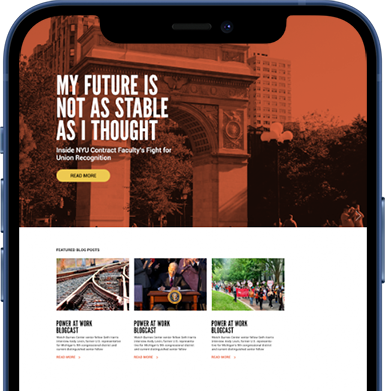The holiday season is here, meaning that many of us will probably find ourselves in an airport sometime during the next few weeks. While some travelers may not think much about who their pilots and flight attendants are –– let alone those workers’ schedules and pay –– many employees of the airline industry have been organizing for better working conditions for months or longer.
In early January 2023, workers at Delta Air Lines held union organizing drives and collected authorization cards to force an election to allow them to be represented by a union. Flight attendants, ramp agents, and mechanics at Delta were all organizing with support from the Association of Flight Attendants-CWA, the International Association of Machinists and Aerospace Workers, and the International Brotherhood of Teamsters respectively.
During the past 20 years, flight attendants at Delta — a notoriously anti-union company since its inception in 1925 — have tried to hold a union election three times, but failed to win enough support. Delta has the lowest percentage of its employees represented by a union among U.S. airlines with only around 20% of the more than 80,000 workers at the company unionized compared to 80% at other major airlines. Now, after the pandemic and the array of upheavals that came with it, many employees across industries feel more passionately about getting a union contract with their employers.
Despite Delta’s claims, many flight attendants, ramp agents and other employees have said that, during the pandemic, the company engaged in schedule cuts and unfair disciplinary write-ups and changed scheduling and procedures without properly notifying workers first. In an article by The Guardian, some workers claimed the airline had created a “culture of fear” at work because of these changes.
Airline workers often reported discriminatory practices and unfair labor conditions prior to the push to unionize around the 1950s. Women were first allowed to become flight attendants in the 1930s; stereotypes abounded that women performed better in the service industry and were more appealing to passengers. Furthermore, the appeal of traveling the world and getting paid, even if not very much, outweighed other job options — like teacher and nurse — at the time.
According to the Association of Flight Attendants, flight attendants during this time were subjected to strict regulations, height and weight requirements, and long and underpaid work days, and many were forced to quit their jobs if they got married or reached a certain age.
These employer-imposed regulations contributed to the increased sexualization and marketing of women by airlines to bolster their business. Here’s a video describing and explaining the airlines’ strategy and the flight attendants’ response:
“The airlines basically tried to sell the stewardesses as sex objects,” said Nell McShane Wulfhart, author of the book “The Great Stewardess Rebellion,” in the Vox video linked above. National Airlines was at the forefront of this phenomenon with their suggestive “Fly Me” campaign, which resulted in a 19% passenger increase for the company in 1972.
Black women eventually led the charge in unionizing and changing hiring practices for flight attendants. Through legal challenges and assistance from their unions, which first began forming in 1945 with the AirLine Stewardesses Association, flight attendants were able to eliminate several explicit discriminatory hiring practices. This video from Vice describes some of the consequences of the sexist approach taken by the airlines to their employees that continues today:
Flight attendants weren’t the only ones who faced — and still face — undesirable working conditions. During the 1930s, when flying was mostly reserved for mail delivery, many pilots experienced “pilot pushing,” or unsafe flying conditions due to being overworked and underpaid.
Pilots on strike in 1960, Walter P. Reuther Library
In 1948, National Airlines’ pilots began a walkout after what the Air Lines Pilots Association said was “the inevitable climax to two years of notoriously poor pilot management relations.” Concerns included air safety because the airline’s mechanics had walked out in solidarity with clerical workers in the same union.
Another concern for pilots over the years has been wages. In 1960, Southern Airways pilots walked out due to the low wages the airline insisted on paying because they were a smaller, regional airline. The strike was the longest in the union’s history, lasting until 1962. It was ultimately successful and set a precedent for unionized pilots working at smaller airlines.
The current organizing push has been motivated, in part, by the disarray the COVID pandemic caused and the huge profits airline companies have seen since. Global airlines are expected to make $10 billion in profit in 2023, according to the Air Transport Association.
The CARES Act, enacted during the pandemic, provided up to $46 billion in loans to aviation businesses. The ALPA and AFA strongly supported the Act and said it was necessary to provide security to the nearly 11 million people employed by the airline industry.
Throughout 2023, airline unions have been successful in negotiating better labor contracts. For example, American Airlines pilots agreed to a new contract in July that would put their pay in line with pilots at United. In March, Delta pilots accepted a contract that includes a raise of 34% over four years. In September, United pilots ratified a new four-year contract that includes improvements in work rules, sick leave, vacation time and retirement benefits for its pilots.
These wins have boosted worker power and morale for workers throughout the airline industry to push for better compensation, better working conditions, and a voice in the workplace through a union. With the industry’s fraught history of employment discrimination and labor challenges, organizing efforts will almost certainly intensify in the coming months.

